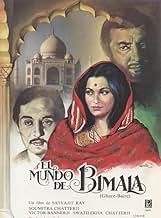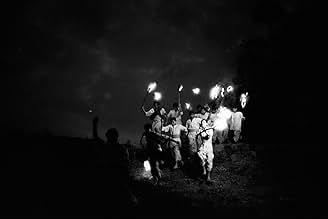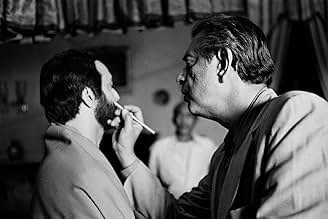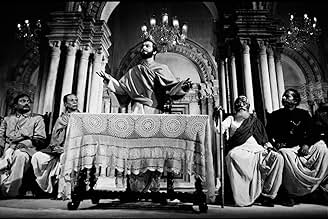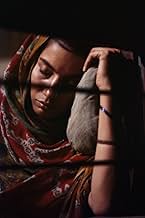IMDb RATING
7.5/10
2K
YOUR RATING
A landowner's wife emerges from seclusion through education, defying social norms. Her newfound freedom leads to political awakening when her husband's old friend brings revolutionary ideas ... Read allA landowner's wife emerges from seclusion through education, defying social norms. Her newfound freedom leads to political awakening when her husband's old friend brings revolutionary ideas to their door.A landowner's wife emerges from seclusion through education, defying social norms. Her newfound freedom leads to political awakening when her husband's old friend brings revolutionary ideas to their door.
- Director
- Writers
- Stars
- Awards
- 3 wins & 2 nominations total
Soumitra Chatterjee
- Sandip Mukherjee
- (as Soumitra Chattopadhyay)
Swatilekha Sengupta
- Bimala Choudhury
- (as Swatilekha Chattopadhyay)
Jennifer Kendal
- Miss Gilby
- (as Jennifer Kapoor)
Bimala Chatterjee
- Kulada
- (as Bimal Chattopadhyay)
- Director
- Writers
- All cast & crew
- Production, box office & more at IMDbPro
Featured reviews
"Dear me, I had no conception that the lower classes had such white skins." - Lord Curzon
Set in the early 1900s, Satyajit Ray's "The Home and the World" features the recollections of Bimala Cloudhury (Swatilekha Chatterjee), the wife of Nikhilesh (Victor Banerjee), a wealthy Bengal merchant. As her spouse encourages her to adopt Western attitudes, Bimala begins to drift away from traditional social and religious values.
By "Home's" second act, it becomes clear that Nikhilesh idolises India's British rulers, who, under the leadership of Lord Curzon, have begun partitioning the Muslim and Hindu populations of Bengal. Ironically, Nikhilesh's desires for Bimala to be "reeducated" have the opposite effect; she's drawn toward a leader of the Swadeshi, a nationalist movement. Indeed, Bimala becomes the movement's first female member.
"Home" thus sketches an India in which forces have begun pulling in opposing directions. Throughout the film, traditional values vie with liberated modernism. This "modernism", ironically, is introduced via the "primitive" hand of British Imperialism, which is itself opposed by an Indian Nationalism whose progressivism not only masks reactionary elements, but points to the eventual disharmony between Hindus and Muslims.
Slow, subtle, and set almost entirely indoors, "The Home and the World" heavily resembles the works of Luchuno Visconti. Like Visconti at his best, Ray's film portrays a society on the cusp of transformation. Bimala's plight, torn between two men, itself echoes the upheaval's of her nation.
8/10 – See "North West Frontier".
Set in the early 1900s, Satyajit Ray's "The Home and the World" features the recollections of Bimala Cloudhury (Swatilekha Chatterjee), the wife of Nikhilesh (Victor Banerjee), a wealthy Bengal merchant. As her spouse encourages her to adopt Western attitudes, Bimala begins to drift away from traditional social and religious values.
By "Home's" second act, it becomes clear that Nikhilesh idolises India's British rulers, who, under the leadership of Lord Curzon, have begun partitioning the Muslim and Hindu populations of Bengal. Ironically, Nikhilesh's desires for Bimala to be "reeducated" have the opposite effect; she's drawn toward a leader of the Swadeshi, a nationalist movement. Indeed, Bimala becomes the movement's first female member.
"Home" thus sketches an India in which forces have begun pulling in opposing directions. Throughout the film, traditional values vie with liberated modernism. This "modernism", ironically, is introduced via the "primitive" hand of British Imperialism, which is itself opposed by an Indian Nationalism whose progressivism not only masks reactionary elements, but points to the eventual disharmony between Hindus and Muslims.
Slow, subtle, and set almost entirely indoors, "The Home and the World" heavily resembles the works of Luchuno Visconti. Like Visconti at his best, Ray's film portrays a society on the cusp of transformation. Bimala's plight, torn between two men, itself echoes the upheaval's of her nation.
8/10 – See "North West Frontier".
I have literally no words to describe this film! Throughout the film, I felt that I was transported back to the early 20th century and watching the events unfold in front of my eyes.
Bimala, the wife of a Bengali zamindar/gentry is the main protagonist of the film. Her conflicts, her transformations (no spoilers) are the main events occuring in the film. To enjoy the flavour of the film, I would suggest you to watch the film from the POV of her.
The film illustrates the two sides of the Swadeshi movement. One group felt that Swadeshi movement was unrealistic and the poor would be hard hit. Another group, the utopian one, felt that Swadeshi would bring freedom to India.
Bimala, the wife of a Bengali zamindar/gentry is the main protagonist of the film. Her conflicts, her transformations (no spoilers) are the main events occuring in the film. To enjoy the flavour of the film, I would suggest you to watch the film from the POV of her.
The film illustrates the two sides of the Swadeshi movement. One group felt that Swadeshi movement was unrealistic and the poor would be hard hit. Another group, the utopian one, felt that Swadeshi would bring freedom to India.
Here is one more film made our of the work of Tagore. The great Kishore Kumar gave his voice for a song in this film. The worst script adapted by Ray I think. It always bugged me how the entire story was converted to a play and the film was made plainly out of it. The story it interesting though - it shows how the 'boycott British product' movement in early 1900s impacted poor people in our country.
"The Home & The World" ( 1984) is based on a novel written by Rabindranath Tagore. It is a simple story of two friends, their friendship & love. Victor Bannerjee plays Nikhilesh, the maharaja while his friend's role is done by Soumitra Chatterjee who was former's class mate. The latter joins the maharaja to promote his political career. Maharaj's wife Bimala Chaudhury( Swatilekha Sengupta) develops a liking for him owing to his persuasive & impressive language. They get amorously involved. The story is reminiscent of Ray's earlier film made way back in 1964 titled " Charulata" featuring Soumitra Chatterjee, Syamal Ghosal, & Madhabi Mukherjee. Many things were common in both films. Both were based on stories by Rabindranath Tagore, the Noble laureate. Both films revolves round a childless married woman who falls for a persuasive speaking visitor, Saumitra Chatterjee ,while her husband watches the scene from the side lines as a passive spectators. In the later film the woman ,who was earlier confined to her 'palace chamber', gets an opportunity to meet the visitor & supports his 'swadeshi movement', too, despite her husband's disapproval. She even steals gold coins from the safe to lend a supporting hand .The film was made on a lavish canvass & it is very difficult to present each aspect or scene here. However, I tried to part with reasonably good information to readers. Interestingly, in both the films the woman returns to her husband .
Read about the great Indian debate between Gandhi and Tagore before watching this movie.
You can see Gandhi in the character of Sandip and Tagore in the character of Nikhil.
Now watch this movie. An absolute masterpiece
Did you know
- TriviaBased on the book "Ghare-Baire" by Rabindranath Tagore. Director Satyajit Ray had previously written a screenplay from this book, but had sold the rights to a group who never filmed the story. 30 years later, Ray rewrote the screenplay for this film.
- ConnectionsReferenced in Z Channel, une magnifique obsession (2004)
- How long is The Home and the World?Powered by Alexa
Details
- Release date
- Country of origin
- Languages
- Also known as
- The Home and the World
- Filming locations
- Tollygunj, Kolkata, India(Studio Set)
- Production company
- See more company credits at IMDbPro
Box office
- Gross worldwide
- $6,951
- Runtime
- 2h 20m(140 min)
- Sound mix
Contribute to this page
Suggest an edit or add missing content

